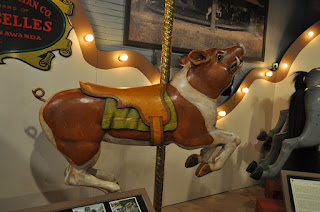A carousel would not be complete without music. The museum owns several beautiful band organs to provide the classic carousel music, all of which are built in Tonawanda, NY. The organ pictured on the left is a Wurlitzer Caliola, made in 1929. This one includes a piano keyboard that can be played along with the other music. The main purpose of the band organs was to attract people's attention and draw them towards the carousel.
The sheet music for a band organ is pictured above. It consists of a very long roll of waxy paper with dots and dashes cut into it. These holes are the notes of the piece of music. One roll of paper can include six to ten songs, with blank spaces in between to separate them.
These rolls of music are created in the perforating shop. First, a worker takes a piece of regular sheet music and then transcribes it to a master roll by carefully cutting out each note. The factory also has large machines which can perforate each smaller roll, making the job quicker.

There is also a player piano at the museum which works in a similar way to the organs. In the picture below, it is easy to see where the roll of waxy paper fits into the piano.














